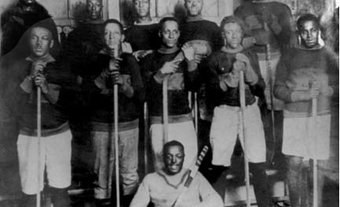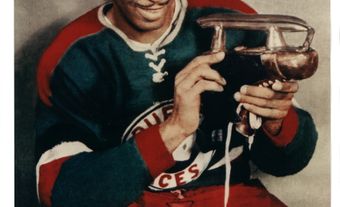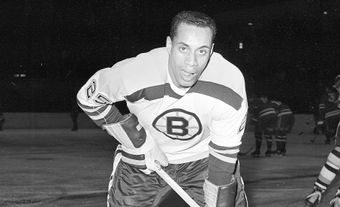The Colored Hockey League of the Maritimes (CHL) was an all-Black men’s hockey league. It was organized by Black Baptists and Black intellectuals and was founded in Halifax, Nova Scotia, in 1895. It was defunct during and after the First World War, reformed in 1921 and then fell apart during the Depression in the 1930s. Play was known to be fast, physical and innovative. The league was designed to attract young Black men to Sunday worship with the promise of a hockey game between rival churches after the services. Later, with the influence of the Black Nationalism Movement — and with rising interest in the sport of hockey — the league came to be seen as a potential driving force for the equality of Black Canadians. Canada Post issued a commemorative stamp in honour of the league in January 2020.

Origins
The roots of organized Black hockey are found in baseball. By the mid-1880s, all- Black baseball clubs were established throughout Nova Scotia and other parts of Eastern Canada. ( See also Chatham Colored All-Stars.) Clubs competed as so-called “barn-storming” teams touring the Canadian countryside. They became year-round semiprofessional sports organizations. Many of their members became two-sport athletes.
The genesis of the Colored Hockey League (CHL) appears to have come from the actions of four men: Pastor James Borden of Dartmouth Church; James A.R. Kinney, a Cornwallis Street Church layman and later the first black graduate of the Maritime Business College; James Robinson Johnston, first black graduate of the Dalhousie University law program; and Henry Sylvester Williams, a Trinidadian law student at Dalhousie and later the founder of the first Pan-African Conference (1900).
These four Nova Scotians were influenced by the writings of contemporary African American leader Booker T. Washington, who wrote: “I have learned that success is to be measured not so much by the position that one has reached in life as by the obstacles which he has overcome while trying to succeed.” They organized the league’s first games and established its purpose.
Structure and Growth
By the early 20th century, the CHL had expanded from a humble three-team league — which included its maiden club, the Dartmouth Jubilees — to include newly formed regional challengers. Some of these had established baseball roots: the Africville Sea-Sides; the Truro Victorias; the Charlottetown West End Rangers; the Amherst Royals; and the Hammond Plains Moss Backs.
The league was organized as a challenge cup system. The previous year’s winner held the title of champion; contending teams vied to earn the right to compete for the title. The structure was akin to that of a boxing championship.
Teams were only permitted arena access after the white leagues were finished with their seasons. As a result, official league games were generally conducted between late January and early March; at that point, the natural ice surface would become too poor to conduct matches. Due to a limited eight-week playing window, championships included only the select three or four top regional teams. They participated in a half dozen games each to determine top honours. Inevitably, disputes arose as to which teams were given the rights to officially compete for a championship.
Games were played with no official rules other than the Bible. The result was, ironically and unintentionally, a more physical and innovative style of hockey. By all accounts, championship games were on par with the best of the white teams. League play was known to be fast-moving and robust. Techniques such as a goaltender dropping to his knees (credited to Henry “Braces” Franklyn) and what may have been an early form of the slapshot (credited to Eddie Martin) were displayed prior to their use in professional hockey league play.
The meteoric rise of the CHL reached its zenith between 1900-05. There were hundreds of players and more than 12 teams. Games often out-drew those of white counterparts. Attendance reached as high as 1,200 spectators for the Inter-Provincial Maritime Championship between the CHL champion Africville Sea-Sides and the Charlottetown West End Rangers in Halifax.
Decline
In the first five years of the 20th century, a dispute over expanded rail service to the port of Halifax caused many hockey players and their families in Africville, the Black community in Halifax, to be at odds with provincial and city officials over a proposed railroad annexation of their land. A five-year legal battle ensued. League organizer James Robinson Johnston represented the families of the Black community in a bid to stop the annexation.
During the legal battle, some rink owners refused to rent to the league or to any Black teams. Other rink owners agreed to only do so in late March when the natural ice surface was already beginning to melt. Local newspaper coverage of the league also disappeared virtually overnight. Only one article was published in 1905-06. With a poor playing surface slowing the game and no means of promotion, the league was forced to move back onto local ponds. This effectively killed the CHL as an economic and social Black movement. The last recorded newspaper account of the league during this era appeared in 1911.
Rebirth in 1921
In 1921, the CHL was reformed with three teams: the Truro Victorias; the Africville Sea-Sides; and the Halifax All-Stars, a team with players from Halifax and Dartmouth. Truro and Halifax had a new and younger generation of Black players. But the Africville team competed with virtually the same roster it boasted in 1901; many of the players were now in their forties. Unlike the earlier CHL, the new league played under standardized hockey rules.
Although the CHL reemerged to some prominence, its social and religious aims were largely forgotten. All the original church and intellectual organizers were by this time deceased. After 1925, teams came and went. New teams formed, sometimes for only brief periods, only to disappear as quickly as they had emerged.
News coverage also faded away again as attention shifted from regional leagues to the National Hockey League (NHL). Black teams such as the Halifax Diamonds, the Halifax Wizards, the New Glasgow Speed Boys, the Africville Brown Bombers and the Truro Sheiks, among others, would compete at various points into the 1930s. But they found themselves long forgotten in the collective consciousness by the time of the Second World War.
Legacy and Honours
A book on the CHL — Black Ice: The Lost History of the Colored Hockey League of the Maritimes, 1895 to 1925 (2004), by brothers George and Darril Fosty — brought renewed attention to the league and its players. In 2015, the CHL was featured in Damon Kwame Mason’s documentary Soul on Ice: Past, Present & Future. In January 2020, Canada Post issued a commemorative stamp featuring an image of Black hockey players on a frozen pond in front of the Halifax Citadel. The stamp reads “Colored Hockey Championship” and includes the names of some of the teams: Jubilees, Stanleys, Eurekas, Sea-Sides, Rangers, Royals and Moss Backs.
See also Trailblazing Black Canadian Athletes; Herb Carnegie; Willie O’Ree; Editorial: Saint Mary’s Players Make Hockey History.

 Share on Facebook
Share on Facebook Share on X
Share on X Share by Email
Share by Email Share on Google Classroom
Share on Google Classroom



